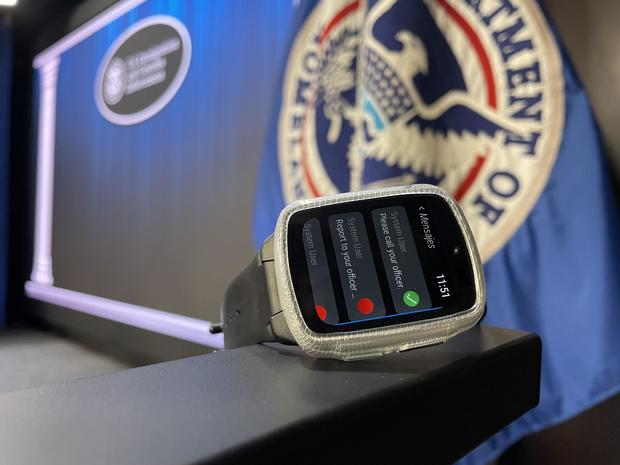Washington — U.S. Immigration and Customs Enforcement (ICE) on Monday unveiled a smartwatch-like device to track migrants released from federal immigration custody, saying the technology could help the government monitor a small fraction of the millions of individuals with pending deportation cases.
The wrist monitor, which uses GPS technology, will be the latest device used by ICE to track migrants enrolled in the Alternatives to Detention program, an agency initiative that the Biden administration has vastly expanded to supervise migrants determined not to pose a risk to public safety or national security, such as asylum-seekers processed along the U.S.-Mexico border.
ICE has previously used ankle monitors, phone calls and a mobile app with face recognition technology to monitor those placed in the alternatives to detention program, which Biden administration officials have argued is a cheaper and more humane way to ensure migrants comply with their immigration proceedings than holding them in detention facilities.
More than 5 million migrants are facing deportation as part of ICE’s non-detained docket of cases, which have ballooned under President Biden amid record apprehensions along the southern border. ICE, however, does not have the personnel or resources to detain or monitor all migrants with deportation cases.
As of earlier this month, roughly 250,000 migrants were being monitored under the alternatives to detention initiative, while another 25,000 were detained in ICE’s network of county jails and for-profit prisons, according to agency data.
The watches will be tested on a pilot basis over several weeks and provided to 50 migrant adults facing deportation near Denver, according to an ICE official who showcased the device to reporters on Monday. Its use could be expanded depending on how the test period goes, the official added.
Camilo Montoya-Galvez / CBS News
The ICE official, who requested anonymity to discuss the program, argued the wrist monitors blend in as they resemble smartwatches, calling them “less intrusive than an ankle monitor.” The daily cost of operating the watch per migrant will be less than $8, which the official said is much cheaper than detention costs.
Along with its GPS feature, the watches can tell time, receive messages from ICE officials and case managers and access a calendar of appointments to allow migrants to check in with officials. Like the phone app ICE has used to track hundreds of thousands of migrants, the wrist monitors were developed by BI Incorporated, a private company.
The watch’s features will be available in English, Spanish, Portuguese and Haitian creole, a BI Incorporated representative said during Monday’s briefing. There are also two versions of the watch: one that migrants will be able to take off and another that ICE will require migrants to wear throughout the entire day.
The removable watch will allow migrants to take it off to charge it or when going to sleep. The non-removable version will trigger an alert if it is taken off that could require migrants to do a face check-in with ICE. It will also be fitted with a clip that would indicate whether migrants attempt to remove it.
ICE will be testing both versions of the watch in Denver during the evaluation period, which is expected to last between 30 and 45 days, the agency official said.
The device is part of a broader Biden administration effort to ensure migrants comply with their immigration proceedings without relying on immigration detention, which has been denounced as inhumane and ineffective by progressive advocates.
In addition to expanding alternatives to detention, the Biden administration has reshaped ICE’s mission, instructing agents to prioritize the arrest of migrants with serious criminal convictions or who pose a national security risk and recent border-crossers. ICE has also ended mass workplace arrests and generally barred the detention of veterans, victims of serious crimes, pregnant women and families with minors.
While the changes have been supported by Democrats and advocates, they have also garnered criticism from congressional Republicans, who have accused the administration of being too lenient on immigration enforcement at a time of historically high migration levels along the U.S.-Mexico border.
While the administration directed ICE to discontinue the detention of migrant families in 2021, officials have discussed reinstating the practice as the government prepares for a spike in migrant arrivals along the southern border after the Title 42 pandemic-era expulsions policy expires in early May.
During a briefing with reporters last week, Homeland Security Secretary Alejandro Mayorkas said no final decision had been made on whether ICE should revive family detention.

